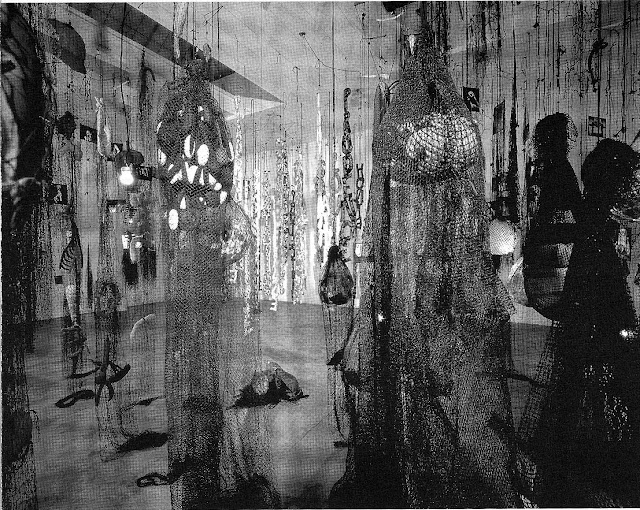Annette Messager "DependanceIndependance" at Gagosian

The most recent exhibition by Annette Messager finds her deconstructing her collective oeuvre through an accruance of the motifs that have previously represented her. Dependance lndependance (1995-97) fills the room of Gagosian Gallery, employing both the scale and cavernous feel of the gallery space.
Dependancelndependance seems a complete departure from the sophisticated games between language and assemblage evident in many of her previous ereations. Whereas in earlier assemblages such as Penetration (1993 94) or Parade (1994 95) there was a tangible separation between the experience of the viewer and the drama enacted by the installation, here Messager seems to intend the complete confusion of the two. Entering the gallery, the first thing one sees is a mass of coils and nets which hold plastic bags filled with colourful masses resembling human organs or lost objects from the distant past. It is difficult to discern relative wholes within the mixture of images and objects. However there are regions dominated by a particular motif, such as headless dolls dressed in black with cotoured pencils puncturing them at every juncture, or photographs of Messager herself making childish faces. These self portraits mock nightmare images: the artist's cheeks are pushed in with tongue protruding; and her hands are pressed to her nose with eyes peering up and away, creating a medusae of harmless but alarming visual expressions. In other areas of the gallery, groups of arms and legs made from plush doll material hang communally, as if to suggest the collective uselessness or exterior appendages in a world created not by action, but its reverse. In other areas still, strings of puffy letters dangle among the nets and webs: ATTENDE...PROMESSE...SOUPÇON...CRAINTE," shouting to the viewer in angst ridden ambiguity. These vertical word hangings are the least representative of Messager's methods and the least effective.
The installation as a whole seems an unfettered miasma of et notions and reasons within the context of its title. Dependence could relate to that of a child upon its parents, or, in Messager's lexicon, to that of a lover upon the object of devotion. My first impression was that I was entering the pathways of the artist's mind, as if Messager was attempting a complete remove (hinted at in previous creations) from the physical world. Instead of composing scenes from a world of darkness, Messager has ejected herself wholeheartedly into that world, willing to accept the loss of identity it promises, along with the transcendence of consciousness. Though the form of her expression is sometimes problematic, lacking the sophistication, humour and sense of ritual evinced by previous small scale assemblages, she still creates an oppressive density of objects that, in falling, remain in collusion yet do not touch one another. Like the characters of a scroll, they unwind together as the tale is told.
C Magazine #53, May-August 1997
Dependancelndependance seems a complete departure from the sophisticated games between language and assemblage evident in many of her previous ereations. Whereas in earlier assemblages such as Penetration (1993 94) or Parade (1994 95) there was a tangible separation between the experience of the viewer and the drama enacted by the installation, here Messager seems to intend the complete confusion of the two. Entering the gallery, the first thing one sees is a mass of coils and nets which hold plastic bags filled with colourful masses resembling human organs or lost objects from the distant past. It is difficult to discern relative wholes within the mixture of images and objects. However there are regions dominated by a particular motif, such as headless dolls dressed in black with cotoured pencils puncturing them at every juncture, or photographs of Messager herself making childish faces. These self portraits mock nightmare images: the artist's cheeks are pushed in with tongue protruding; and her hands are pressed to her nose with eyes peering up and away, creating a medusae of harmless but alarming visual expressions. In other areas of the gallery, groups of arms and legs made from plush doll material hang communally, as if to suggest the collective uselessness or exterior appendages in a world created not by action, but its reverse. In other areas still, strings of puffy letters dangle among the nets and webs: ATTENDE...PROMESSE...SOUPÇON...CRAINTE," shouting to the viewer in angst ridden ambiguity. These vertical word hangings are the least representative of Messager's methods and the least effective.
The installation as a whole seems an unfettered miasma of et notions and reasons within the context of its title. Dependence could relate to that of a child upon its parents, or, in Messager's lexicon, to that of a lover upon the object of devotion. My first impression was that I was entering the pathways of the artist's mind, as if Messager was attempting a complete remove (hinted at in previous creations) from the physical world. Instead of composing scenes from a world of darkness, Messager has ejected herself wholeheartedly into that world, willing to accept the loss of identity it promises, along with the transcendence of consciousness. Though the form of her expression is sometimes problematic, lacking the sophistication, humour and sense of ritual evinced by previous small scale assemblages, she still creates an oppressive density of objects that, in falling, remain in collusion yet do not touch one another. Like the characters of a scroll, they unwind together as the tale is told.
C Magazine #53, May-August 1997
Comments